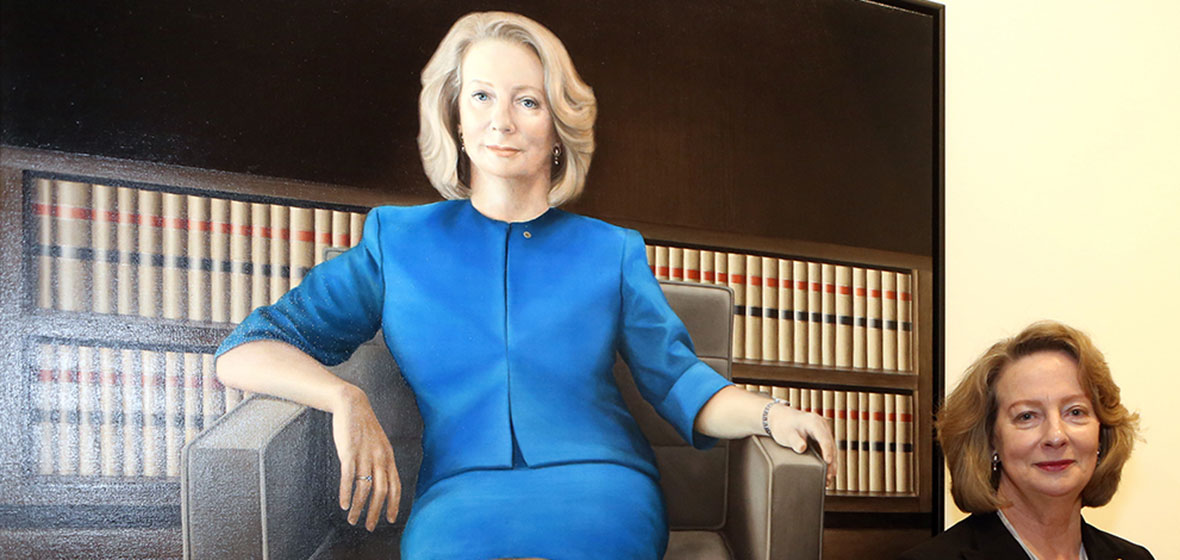Snapshot
- On 30 January 2017, Susan Kiefel was sworn in as the first female Chief Justice of the High Court of Australia.
- In Australia, with its system of judicial appointments made behind closed doors and with limited insight into selection criteria, swearing-in ceremonies provide a rare opportunity for the public airing of the attributes of judicial appointees.
- Chief Justice Kiefel’s ceremony was the first time a high court swearing-in ceremony was broadcast live on national television, and may mark a shift in public and scholarly attention paid to these rituals.
At 10.15 am on 30 January 2017, Susan Kiefel was sworn-in as Chief Justice of the High Court of Australia.
Swearing-in ceremonies operate alongside the open hearing of cases and the production of reasons for decision as an institutional feature of courts designed to reinforce transparency and public confidence in the judiciary. As a collective ‘ceremonial archive’, transcripts of ceremonial proceedings are also vital records of the history of the judiciary and legal profession in Australia. Chief Justice Kiefel’s ceremony was the first time a High Court swearing-in ceremony was broadcast live on national television, and so may mark a shift in public and scholarly attention paid to these rituals.
More than Sir Owen Dixon: glimpsing judicial philosophy and personality through swearing-in ceremonies
In Australian legal history, only Sir Owen Dixon’s swearing-in speech of 1952 has gained significant attention. It was in this speech that he famously remarked:
‘[C]lose adherence to legal reasoning is the only way to maintain the confidence of all parties in Federal conflicts. It may be that the court is thought to be excessively legalistic. I should be sorry to think that it is anything else. There is no other safe guide to judicial decisions in great conflicts than a strict and complete legalism.’
Two ironies attend this statement. First, that the only famous words of a swearing-in speech are those the judge himself later regretted. Second, that a statement that for decades has reinforced the primacy of a textualist approach to judicial reasoning was itself espoused in an extra-judicial speech.
The fame of Dixon CJ’s speech has also tended to overshadow the potential that other judges’ swearing-in speeches may also provide insight into judicial personality and philosophy. Consider the following passage from the speech Sir William Deane gave when he was sworn in as a Justice of the High Court of Australia in 1982:
‘The source of law and of judicial power in a true political democracy such as Australia is the people themselves: the governed: the strong and the weak, the rich and the poor, the good and the bad: “all manner of people” … The grant of judicial power by the people was subject to what I see as fundamental constitutional guarantees, namely, that the power granted must primarily be exercised by an independent judiciary and that those exercising the power must act judicially.’
This statement encapsulated a powerful, innovative, vision of the authority of the Constitution, and the Court’s role as its interpreter. Conventional theory of 1982 held that the Constitution derived its authority from its status as an Act of Imperial Parliament, and was an instrument designed for the division of power by government, not for the protection of individual liberties. In this speech Deane J clearly signaled that he embraced a different concept of the relationship between the people and the Constitution; an approach which later underpinned his reasoning in cases such as University of Wollongong v Metwally (1984) 158 CLR 447; Australian Capital Television v Commonwealth (1992) 177 CLR 106; and Leeth v Commonwealth (1992) 174 CLR 455.
Seated in the Gallery of Courtroom 1 on 30 January, I cannot claim that Kiefel CJ’s depiction of legal themes in her speech left me with the same sense of a ‘zinger’ as Sir Owen Dixon’s iconic four words, or of Deane J’s succinct encapsulation of his constitutional philosophy. However, two key reflections by Kiefel CJ on the judicial process are likely to attract future attention.
Comparative law: In both her swearing-in speeches in the High Court, in 2007 and 2017, her Honour reflected on the benefits of comparative legal analysis for informed legal and judicial reasoning. The prominence of comparative law in Kiefel J’s reasoning between 2007 and 2016 was a noted thread surrounding the news of her elevation to the position of Chief Justice, and in Attorney-General Brandis’s welcome speech to the judge on 30 January 2017. The fact that Kiefel CJ chose again to refer to the insights of comparative legal analysis on this historic occasion is therefore likely to frame further discussion on the topic.
Collegiality: A new – but also expected – reference in Kiefel CJ’s 2017 swearing-in speech was to collegiality in the Court. Her Honour’s thoughts on the topic, as expressed in her extra-judicial publication ‘The Individual Judge’ (2014) 88 ALJ 554, had garnered significant attention in commentary surrounding her appointment. By referencing the term on this occasion, Kiefel CJ must be taken to endorse ‘collegiality’ as a touchstone for later discussion of her judicial philosophy, and the approach of the Kiefel Court.




